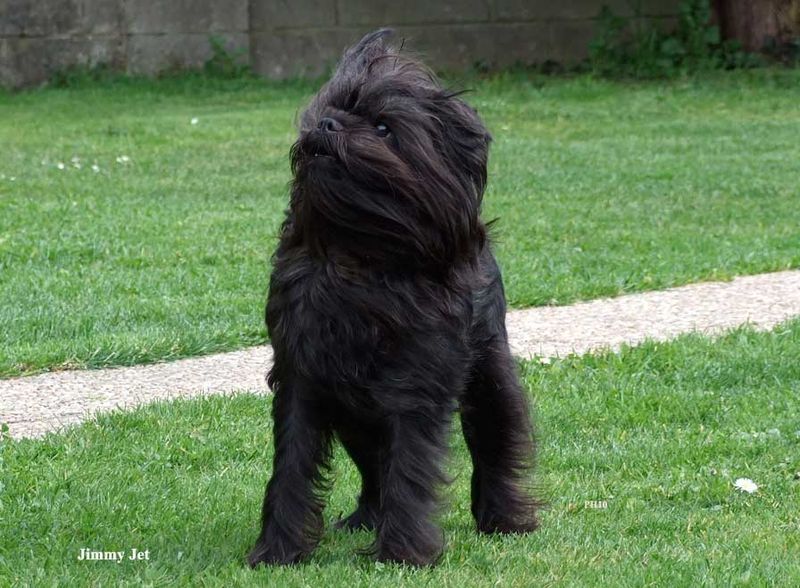File:Jjmarch10.jpeg

Original file (896 × 659 pixels, file size: 83 KB, MIME type: image/jpeg)
Captions
Captions
Summary[edit]
An odd name for such a singular breed of dog. The name of a breed normally gives us a clue as to the appearance or the work carried out by the breed, but the name of the Affenpinscher means nothing unless you have some knowledge of German. And even for the Germans, as far as we can tell, the meaning is unclear. In German the verb “äffen” means “to imitate -often in an ironic way”. The adjective “affenartig” means “monkey-like” or “simian” ("Affe"= "Monkey"). “Affenschande” means “great shame (ashamed)” and perhaps we could remember the terms “shameless”, “ daring” or “bold” to the character of the breed. At times it has been called “monkey terrier”. Those who first gave rise to the breed in Germany gave the early examples the name ( according to them very descriptive) “little monkey dog”: “Zwerg” which means “dwarf”, "small version, variety", “Affe” means “monkey” and “Pinscher” is the name German people call a type of dog who "pinchs" rats and mice in the stables. It is often said that it looks like a monkey (in German dog breed books often the singular explanation for the name of this breed). This is said largely because it has a prominent underjaw and a moustache. However, monkeys do not have such prominent underjaws, and even fewer have a moustache. Maybe its expression could remind us, a little, of a macaque. But even so, the Affenpinscher has undeniable comic expressions, and people everywhere associate a comic and mischievous expression with monkeys. In France the breed is called “Diablotin Mostachu”, little devil (fig. monkey) with whisker. Dogs of the Affenpinscher type have been known since at least 1600. They were larger, someone about 18” (45,7cm). There was a great variety of colours: grey, black, cinnamon, black and tan, grey and tan, even red. They tended to have white patches on the chest and legs. They were well known as ratting dogs, they lived on farms and in granaries, running at large and sleeping in the stables. Their principal mission in life: catch rats.
By Pilar Hannan Translated by Chris Hannan
Licensing[edit]

|
Permission is granted to copy, distribute and/or modify this document under the terms of the GNU Free Documentation License, Version 1.2 or any later version published by the Free Software Foundation; with no Invariant Sections, no Front-Cover Texts, and no Back-Cover Texts. A copy of the license is included in the section entitled GNU Free Documentation License.http://www.gnu.org/copyleft/fdl.htmlGFDLGNU Free Documentation Licensetruetrue |
- You are free:
- to share – to copy, distribute and transmit the work
- to remix – to adapt the work
- Under the following conditions:
- attribution – You must give appropriate credit, provide a link to the license, and indicate if changes were made. You may do so in any reasonable manner, but not in any way that suggests the licensor endorses you or your use.
File history
Click on a date/time to view the file as it appeared at that time.
| Date/Time | Thumbnail | Dimensions | User | Comment | |
|---|---|---|---|---|---|
| current | 19:19, 6 March 2010 |  | 896 × 659 (83 KB) | Belgazou (talk | contribs) | An odd name for such a singular breed of dog. The name of a breed normally gives us a clue as to the appearance or the work carried out by the breed, but the name of the Affenpinscher means nothing unless you have some knowledge of German. And even for |
You cannot overwrite this file.
File usage on Commons
The following page uses this file:
File usage on other wikis
The following other wikis use this file:
- Usage on sv.wikipedia.org
Metadata
This file contains additional information such as Exif metadata which may have been added by the digital camera, scanner, or software program used to create or digitize it. If the file has been modified from its original state, some details such as the timestamp may not fully reflect those of the original file. The timestamp is only as accurate as the clock in the camera, and it may be completely wrong.
| _error | 0 |
|---|